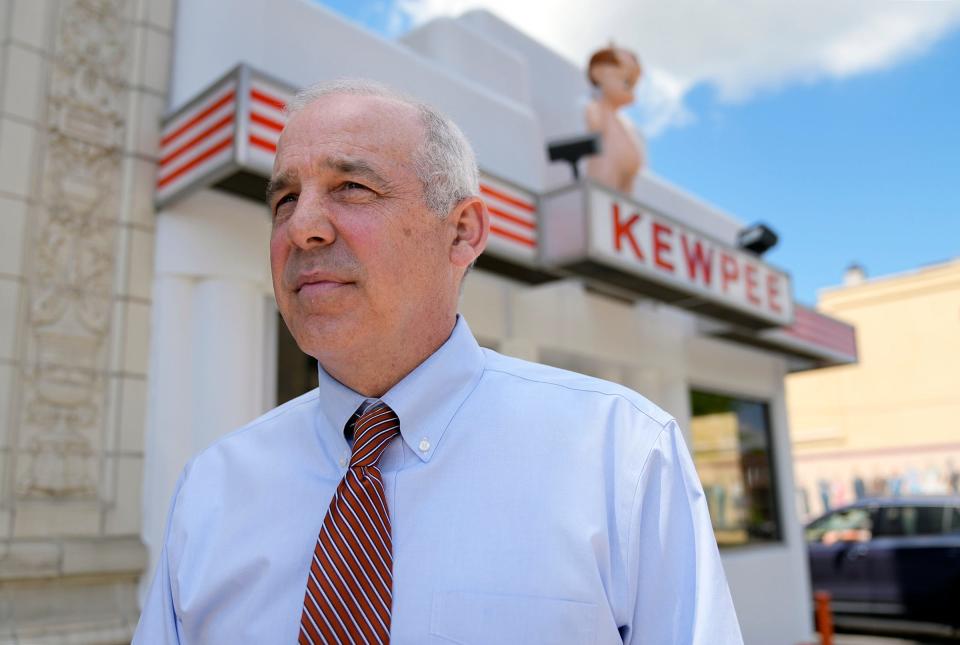Every Ohio child will be eligible for a school voucher but many won't be able to use them

All Ohio children will be eligible for a voucher they can use to pay for private school starting in October, but that doesn't mean every child has a choice.
Most of the state's eligible nonpublic schools are located in and around its cities, leaving large swathes of Appalachia and rural Ohio without alternatives.
"The school choice where I'm from is open enrollment," Rep. Jay Edwards, R-Nelsonville, said. "It's parents who maybe send their kid to another public school because of a sports team or coach."
Half of Ohio's nearly 170,000 private school students live in the three largest counties - Cuyahoga, Franklin and Hamilton - according to data from the Ohio Department of Education. Another 12% come from their neighboring counties. Meanwhile, two of the four counties Edwards represents in the Athens area have zero students in nonpublic schools; Another has 26.
"Even though I have no school choice in my district, I'm not against it," Edwards said. "I understand not everyone learns well in traditional settings."
But the Appalachian lawmaker still isn't sure that Ohio's universal voucher program will provide choice for all.
Increased eligibility doesn't mean increased access
One of the big question marks around Ohio's move to universal eligibility is how many students will make the jump from public to private.
Estimates from the nonpartisan Legislative Services Commission at the Statehouse have put the number around 10,000, meaning most of the $1 billion estimate for school vouchers in the 2025 fiscal year comes from existing private school students.
Edwards also suspects most of the students who make the move will be middle and upper-middle-class families, or those in families earning more than the current income-based voucher limit of about $65,000 in annual earnings for a family of four. "My prediction is you’re not going to see any uptick from 250% (of the federal poverty level) and below."
More: Analysis says universal voucher bill could cost $1 billion, supporters say that's unlikely
Building new schools is expensive, and it can take years, especially to raise the millions often needed for construction. That means what Ohio spends on EdChoice scholarships will depend on how fast private schools can and/or want to build.
"The capacity issue is the next big issue on the horizon for school choice," Senate President Matt Huffman, R-Lima, said. "If there’s no place for you to go, then there’s no school choice."

Huffman's mulling a plan to give grants or some kind of state financial assistance to private schools looking to build new buildings or expand into "choice deserts."
It's a move Rep. Dani Isaacsohn, D-Cincinnati, characterized as the wrong answer to the question about increasing school choice.
"The answer to our underfunded and underperforming public schools is not private schools," Isaacsohn said. "The answer is not running away from our problems. It’s addressing them."
Ohio Education Association President Scott DiMauro went a step further, calling the idea of building private schools with public dollars a blatant attempt "to destroy public education."
But rural Republicans didn't immediately say no.
Edwards told the USA TODAY Network Ohio Bureau he'd be open to conversations, providing they included a long-term commitment to fully funding public schools. The same was true for Rep. Jon Cross, R-Kenton.
"I certainly support school choice. I support vouchers, but I also want to make sure we support our publicly funded schools," Cross said. "You can do both. I think there is room in the budget to do both."
The lifelong Catholic would send his children to private school if one existed near him.
"We would instantly put our kids in Catholic schools, not because our public schools are bad, but because of our faith," Cross said. "It doesn't work for us because the closest one is 45 minutes away."
More money, more oversight?
Kenton had a Catholic school once upon a time. Cross' grandmother attended it. But if the state is going to help build the next one and cover at least part of its tuition fees, he'd like a little more oversight.
The House version of the state budget directed the Ohio Department of Education to develop a set of academic outcomes (graduation rates, test scores) that would give lawmakers a clear picture of how EdChoice students perform compared to their public school counterparts.
The Senate took that out.
"We don't mind making an investment, but what's our return?," Cross said. "We make business decisions to get the best bang for our constituents' bucks. Give us the data. Give the facts that any small business owner or CEO would want. We can't make $1 billion financial decisions without having the right information in front of us."
He also asked what capacity issues at private schools say about the public options.
"School choice doesn't fix failing schools or even help good schools continue to get better," Cross said. "Fully funding our public schools is to make sure every child gets a quality education."
Huffman's idea of a private school construction fund is still in its nascent stage, but he thinks he's slowly but surely convincing his GOP colleagues of the positives that come from increasing school choice.
"When I started down my school choice stuff 15 years ago, one of the big opposition groups were rural Republicans," Huffman said. "But they watched what was going on during COVID and these culture wars. I think they're now on my side."
Anna Staver is a reporter for the USA TODAY Network Ohio Bureau, which serves the Columbus Dispatch, Cincinnati Enquirer, Akron Beacon Journal and 18 other affiliated news organizations across Ohio.
Get more political analysis by listening to the Ohio Politics Explained podcast
This article originally appeared on The Columbus Dispatch: Ohio passed universal vouchers, now it eyes private school capacity

 money
money 